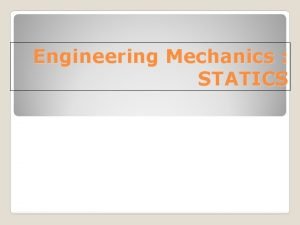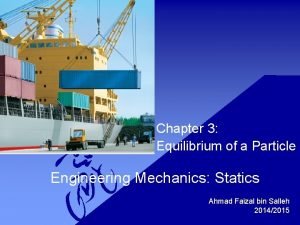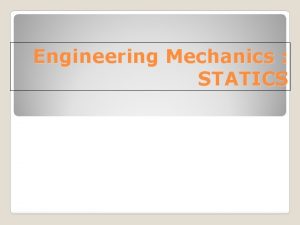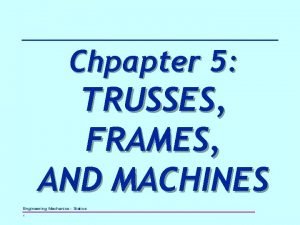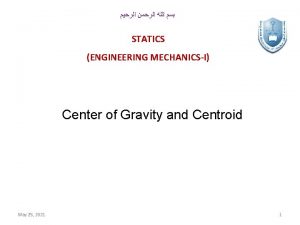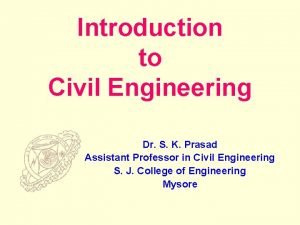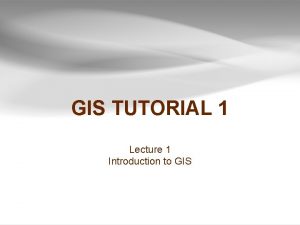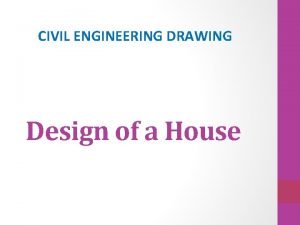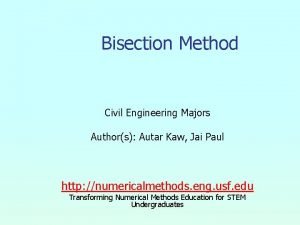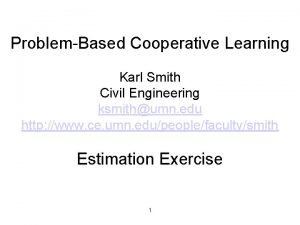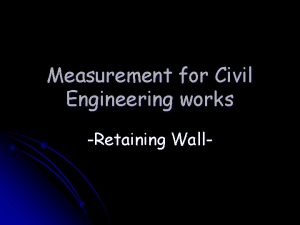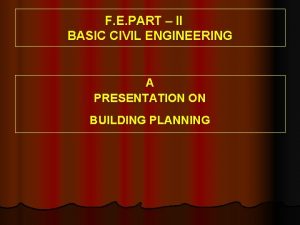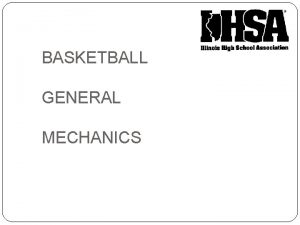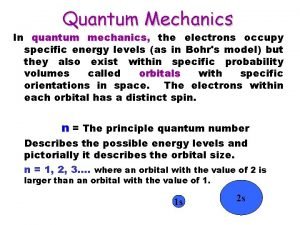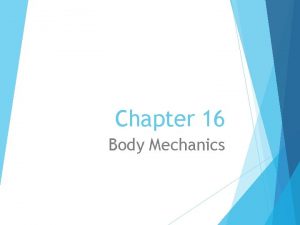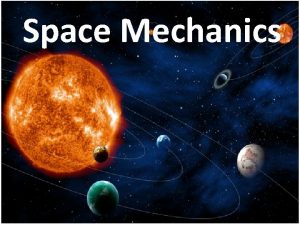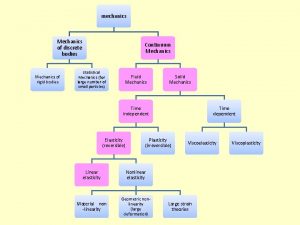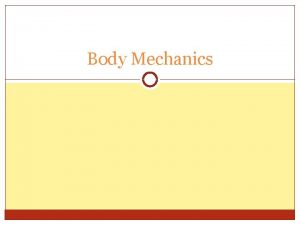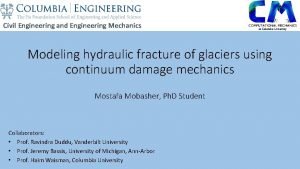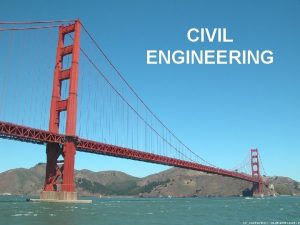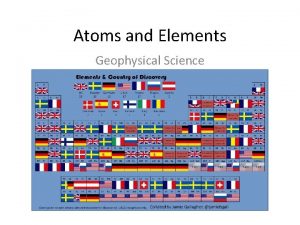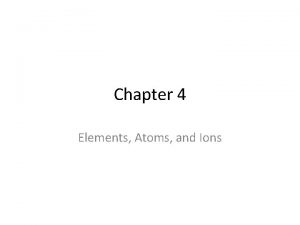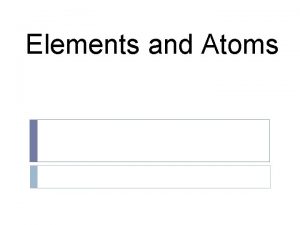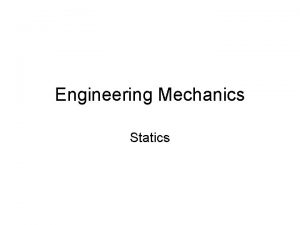Elements of Civil Engineering and Engineering Mechanics 2




















- Slides: 20

Elements of Civil Engineering and Engineering Mechanics 2 Engineering Mechanics Prof. Praveen Biradar (Civil Engg Dept) BLDEA’s V P Dr. P G Halakatti College of Engg. & Tech. , Vijayapur PRAVEEN BIRADAR, BLDEA CET, VIJAYAPUR

Mechanics: - It is the branch of physics which deals with the study of effect of force system acting on a particle or a rigid body which may be at rest or in motion. Engineering Mechanics: - It deals with the application of principles of mechanics & different laws in a systematic manner. PRAVEEN BIRADAR, BLDEA CET, VIJAYAPUR

Classification of Mechanics PRAVEEN BIRADAR, BLDEA CET, VIJAYAPUR

Idealisation or Assumptions in Mechanics Particle: A body of infinitely small volume whose mass can be neglected, is called a particle. Body: The assemblage of a number of particles is known as a body. Rigid body: A rigid body is one in which the positions of the constituent particles do not change under the application of external forces, such as the position of particles 1 and 2 in Figure PRAVEEN BIRADAR, BLDEA CET, VIJAYAPUR

Idealisation or Assumptions in Mechanics Deformable body: A rigid body is one in which the positions of the constituent particles change under the application of external forces, such as the position of particles 1 and 2 in Figure Continuum: A continuous distribution of molecules in a body without intermolecular space is called the continuum PRAVEEN BIRADAR, BLDEA CET, VIJAYAPUR

Laws of Mechanics Newton’s First law: This law states that ‘every body continues in its state of rest or of uniform motion along a straight line, so long as it is under the influence of a balanced force system’. Newton’s Second law: The rate of change of momentum of a body is directly proportional to the force acting on it and takes place in the direction of the force. (F=Ma) Newton’s Third law: This law states that ‘action and reaction are equal in magnitude but opposite in direction’. PRAVEEN BIRADAR, BLDEA CET, VIJAYAPUR

Law of transmissibility of force : Force can be transmitted from one point to another on its line of action without causing any change in the state of its motion. PRAVEEN BIRADAR, BLDEA CET, VIJAYAPUR

Parallelogram law of forces: This law is applicable to determine the resultant of two coplanar concurrent forces only. This law states that If two forces acting at a point are represented both in magnitude and direction by the two adjacent sides of a parallelogram, then the resultant of the two forces is represented both in magnitude and direction by the diagonal of the parallelogram passing through the same point. ” PRAVEEN BIRADAR, BLDEA CET, VIJAYAPUR

Principle of Physical independence of forces When two or more forces act on an object, every force produces its own effect on the object independent of the remaining forces . Principle of superposition of force: This principle states that the net effect of a system of forces on a body is same as that of the combined effect of individual forces on the body. PRAVEEN BIRADAR, BLDEA CET, VIJAYAPUR

Force and its charecteristics Force: It is the physical quantity that changes or tends to change the state of rest or of uniform motion of an object. The SI unit of force is newton. A force can be identified by its four characteristics: (i) Magnitude: The length of the vector represents the magnitude of force (ii) Direction: The direction of a force can be represented by an arrowhead. (iii) Line of action: It is the line along which the force acts. (iv) Point of application: It is the point at which the force acts. PRAVEEN BIRADAR, BLDEA CET, VIJAYAPUR

Force and its charecteristics In fig, the weight of man standing on ladder is shown as force applied at point “C” a) Magnitude – 750 N b) Point of application is at “C”. c) Line of action is vertical. d) direction is downwards PRAVEEN BIRADAR, BLDEA CET, VIJAYAPUR

Classification of Force system Depending upon their relative positions, points of applications and lines of actions, the different force systems can be classified as follows. 1) Collinear forces: It is a force system, in which all the forces have the same line of action. 2) Coplanar parallel forces: It is a force system, in which all the forces are lying in the same plane and have parallel lines of action. PRAVEEN BIRADAR, BLDEA CET, VIJAYAPUR

3) Coplanar Concurrent forces: It is a force system, in which all the forces are lying in the same plane and lines of action meet a single point. Ex. : The forces in the rope and pulley arrangement. 4) Coplanar non-concurrent forces: It is a force system, in which all the forces are lying in the same plane but lines of action do not meet a single point. Ex. : Forces on a ladder and reactions from floor and wall, when a ladder rests on a floor and leans against a wall. PRAVEEN BIRADAR, BLDEA CET, VIJAYAPUR

5) Non- coplanar parallel forces: It is a force system, in which all the forces are lying in the different planes and still have parallel lines of action. Ex: The forces acting and the reactions at the points of contact of bench with floor in a classroom. 6) Non- coplanar concurrent forces It is a force system, in which all the forces are lying in the different planes and still have common point of action. Ex. : The forces acting on a tripod when a camera is mounted on a tripod PRAVEEN BIRADAR, BLDEA CET, VIJAYAPUR

7) Non- coplanar non-concurrent forces: It is a force system, in which all the forces are lying in the different planes and also do not meet a single point. Ex. : Forces acting on a building frame. PRAVEEN BIRADAR, BLDEA CET, VIJAYAPUR

Warm up study Reference: - J. L. Meriam, L. G. Kraige-Engineering Mechanics statics 1 -Wiley PRAVEEN BIRADAR, BLDEA CET, VIJAYAPUR

Warm up PRAVEEN BIRADAR

PRAVEEN BIRADAR

Reference: - J. L. Meriam, L. G. Kraige-Engineering Mechanics statics 1 -Wiley PRAVEEN BIRADAR, BLDEA CET, VIJAYAPUR

END PRAVEEN BIRADAR, BLDEA CET, VIJAYAPUR
 Civil rights and civil liberties webquest
Civil rights and civil liberties webquest Ndsu industrial engineering
Ndsu industrial engineering Center of gravity statics
Center of gravity statics Particle equilibrium in 2d and 3d engineering mechanics
Particle equilibrium in 2d and 3d engineering mechanics Statics centroid
Statics centroid Space truss example
Space truss example Centroid in mechanics
Centroid in mechanics Master of civil engineering unsw
Master of civil engineering unsw Hse in civil engineering
Hse in civil engineering Risk management in civil engineering
Risk management in civil engineering Tam grout
Tam grout What is formwork in civil engineering
What is formwork in civil engineering Introduction to civil engineering
Introduction to civil engineering Role of civil engineering
Role of civil engineering Gis applications in civil engineering
Gis applications in civil engineering Czech technical university in prague civil engineering
Czech technical university in prague civil engineering Civil engg drawing house planning
Civil engg drawing house planning Bisection method application in civil engineering
Bisection method application in civil engineering Umn civil engineering
Umn civil engineering How to measure for a retaining wall
How to measure for a retaining wall Roominess in civil engineering
Roominess in civil engineering


